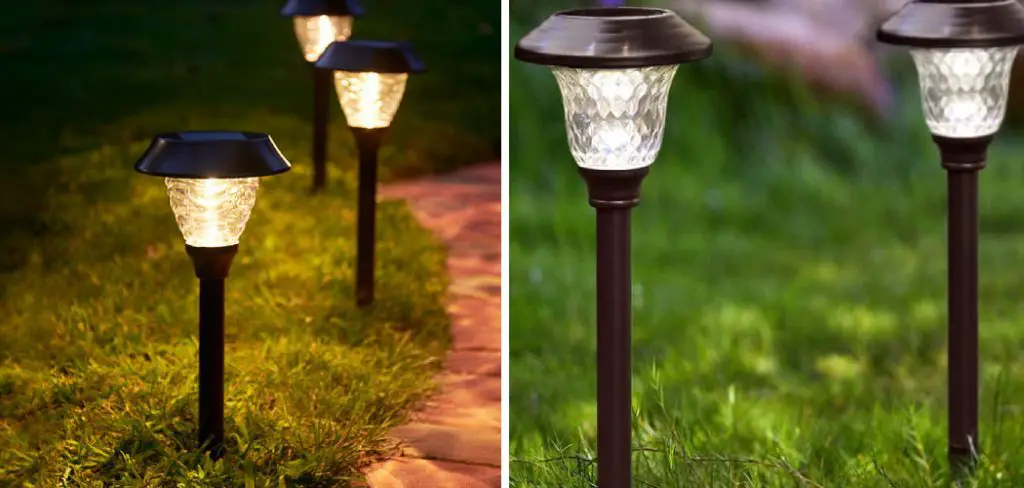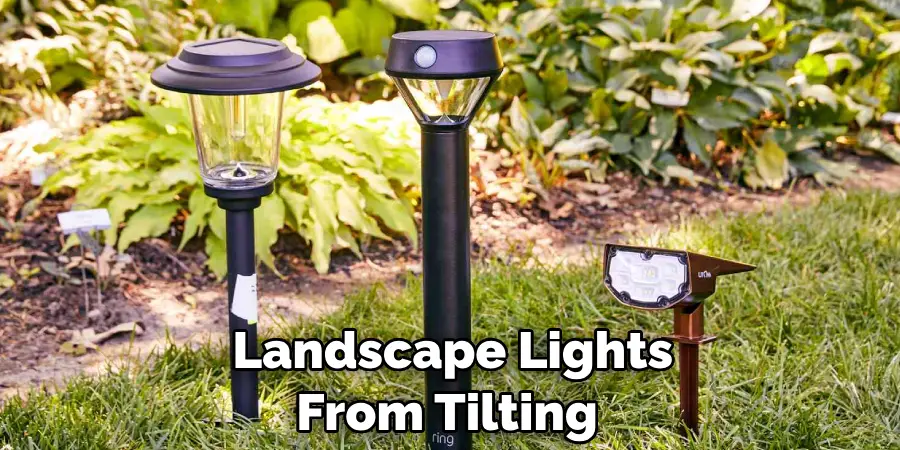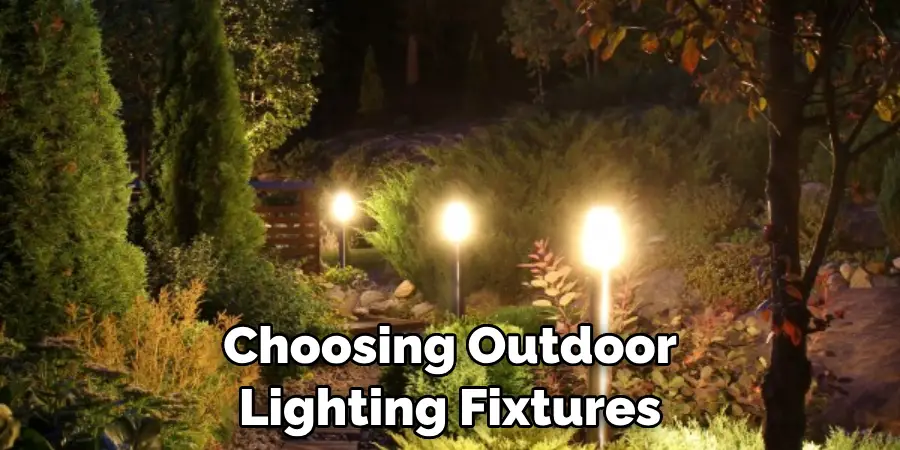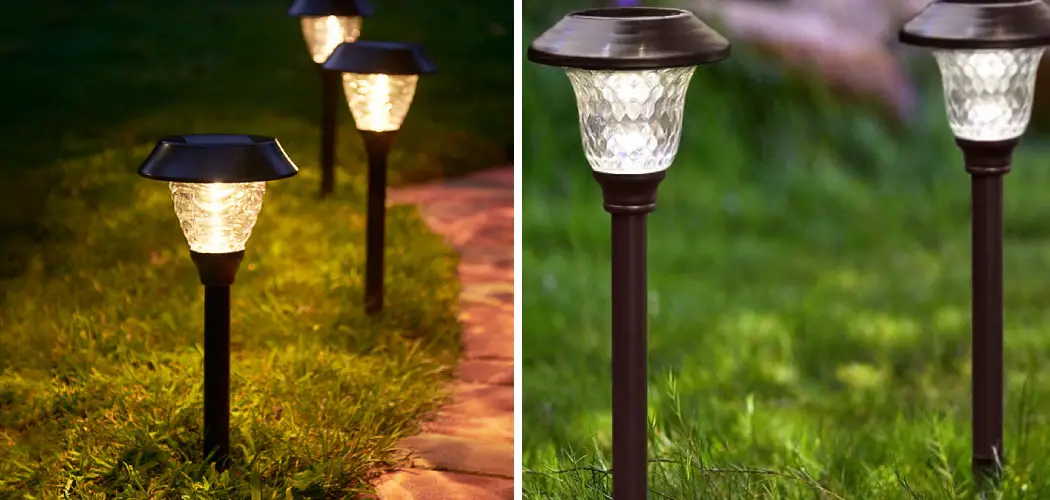Outdoor lighting is an essential aspect of any property, whether it’s a residential or commercial space. It provides safety and security, enhances the aesthetic appeal of the property, and increases its value. Outdoor lighting can be used to illuminate walkways, driveways, patios, and gardens, making them more accessible and enjoyable at night.

It can also be used to highlight architectural features and create a welcoming atmosphere for guests. In this blog post, we’ll walk you through the steps on how to keep landscape lights from tilting so that you can get back to using it in no time! So grab your tools, and let’s get started!
Common Problems with Outdoor Lighting
Uneven lighting can be a major issue for outdoor spaces, as it can create areas that are difficult to navigate or even dangerous. For example, if a pathway is too bright in some areas and too dark in others, it can be difficult for people to see where they are going and avoid tripping or stumbling.
Similarly, if a parking lot is unevenly lit, it can be difficult for drivers to see other cars or pedestrians, increasing the risk of accidents. Flickering lights can also be a significant problem, as they can be distracting or even disorienting.
Importance of Proper Outdoor Lighting
In addition to safety and security, proper outdoor lighting can also improve the functionality of outdoor spaces. With well-placed lighting, outdoor areas can be used for entertaining, dining, and relaxation even after the sun goes down. This allows homeowners to make the most of their outdoor spaces and enjoy them year-round.
Additionally, outdoor lighting can highlight landscaping features such as trees, shrubs, and flower beds, adding depth and dimension to the property. With the right combination of lighting fixtures and placement, homeowners can create a warm and inviting atmosphere that enhances the overall beauty of their home.
10 Methods How to Keep Landscape Lights from Tilting
Method 1: Secure with Ground Stakes
Using ground stakes is a simple yet effective way to prevent landscape lights from tilting. These stakes provide stability by anchoring the fixtures firmly into the ground. Make sure to choose high-quality stakes that are appropriate for the type and weight of your lights. Insert the stakes deep into the soil, ensuring a secure and stable foundation.

Method 2: Install a Concrete Base
For areas with loose or sandy soil, installing a concrete base can offer enhanced stability. Dig a hole, place a sturdy PVC pipe or metal conduit vertically, and pour concrete around it. Once the concrete has set, attach the landscape light fixture to the top of the pipe or conduit. This method provides a solid foundation, preventing tilting even in challenging soil conditions.
Method 3: Utilize Mounting Brackets
Mounting brackets are specifically designed to secure landscape lights in place. These brackets can be attached to walls, posts, or other surfaces to provide additional support and stability. Ensure that the brackets are compatible with your light fixtures and follow the manufacturer’s instructions for proper installation.
Method 4: Opt for Adjustable Knuckles
Some landscape lights come with adjustable knuckles that allow you to change the angle and direction of the light beam. By properly adjusting the knuckles and tightening them securely, you can minimize the risk of tilting. Regularly inspect and readjust the knuckles as needed to maintain the desired lighting position.
Method 5: Use Weighted Bases
Weighted bases are an excellent solution for preventing landscape lights from tilting in areas prone to strong winds or ground movement. These bases are designed to add extra stability by increasing the weight at the bottom of the fixture. Select weighted bases that are suitable for your specific light fixtures and install them according to the manufacturer’s instructions.
Method 6: Employ Underground Anchoring
In areas where landscape lights are exposed to frequent foot traffic or accidental bumps, underground anchoring can help secure the fixtures. Dig a hole next to the light fixture and insert a metal or plastic anchor. Connect the anchor to the fixture using a durable cable or chain. This method ensures that the lights remain in position, even if they are accidentally knocked or bumped.

Method 7: Reinforce with Support Wires
For taller landscape lights or those installed in areas with challenging soil conditions, support wires can provide additional stability. Attach wires from the light fixture to nearby structures, such as trees or posts, to keep the lights from tilting. Ensure that the wires are taut but not overly tight, allowing the lights to maintain their intended position.
Method 8: Consider Ground-Embedded Lights
Ground-embedded lights are an alternative option that eliminates the risk of tilting altogether. These fixtures are installed flush with the ground, reducing the chances of movement or instability. Ground-embedded lights provide a seamless and integrated lighting solution while minimizing maintenance and potential tilting issues.
Method 9: Regular Maintenance and Inspections
Proactive maintenance and regular inspections are essential for preventing landscape lights from tilting. Periodically check the fixtures to ensure they are tightly secured and in proper alignment. Replace any damaged or worn-out parts promptly. Additionally, adjust the lights if any changes in the landscape, such as soil erosion or plant growth, affect their stability.
Method 10: Seek Professional Assistance
If you encounter persistent tilting issues with your landscape lights, it may be beneficial to seek professional assistance. A landscape lighting specialist or electrician can assess the situation, identify the underlying causes, and recommend appropriate solutions. Their expertise and experience can help resolve tilting problems effectively and ensure the long-term stability of your landscape lighting system.
Tips for Choosing the Right Outdoor Lighting Fixtures
When choosing outdoor lighting fixtures, it’s important to consider the purpose of the lighting, the style of the property, and the durability of the materials. For example, if the lighting is for security purposes, motion sensor lights may be the best option. If the property has a modern style, sleek and minimalist fixtures may be more appropriate. Choosing durable and weather-resistant materials can ensure that the fixtures last for years to come.

How to Install Outdoor Lighting Properly
When installing outdoor lighting, it’s important to consider the purpose of the lighting. Is it for security, aesthetics, or both? This will determine the placement and type of fixtures needed. It’s also important to consider the power source and wiring needed for the lighting. Following safety guidelines is crucial to prevent electrical hazards and ensure the longevity of the lighting system.
This includes using weather-resistant materials and grounding all fixtures properly. Using proper tools and equipment, such as a ladder or drill, can also prevent accidents during installation. If the installation requires electrical work beyond your expertise, it’s important to hire a licensed electrician to ensure the job is done safely and up to code.
Maintenance Tips for Outdoor Lighting
Regular maintenance of outdoor lighting is essential to ensure that it continues to function properly and look its best. Over time, outdoor lighting fixtures can become dirty and corroded, which can affect their performance and appearance. To prevent this from happening, it’s important to clean the fixtures and lenses regularly.
This can be done using a soft cloth and a mild soap solution. In addition, bulbs should be replaced as needed to ensure that the lighting is bright and consistent. Checking the wiring and connections is also important, as loose or damaged wires can cause the lighting to malfunction or even pose a safety hazard.
Energy-Efficient Outdoor Lighting Solutions
Energy-efficient outdoor lighting solutions are becoming increasingly popular as people become more aware of the benefits they offer. By choosing these solutions, homeowners can save money on their electricity bills while also reducing the environmental impact of their property.
One of the most popular options for energy-efficient outdoor lighting is LED bulbs. These bulbs use less energy than traditional bulbs and last longer, making them a cost-effective choice. Another option is solar-powered fixtures, which use renewable energy from the sun to power the lights.
Creative Outdoor Lighting Ideas
In addition to these ideas, there are many other creative outdoor lighting options to consider. For example, string lights can be hung from trees or pergolas to create a cozy and inviting atmosphere. Lanterns and candles can also be used to add a warm and romantic glow to outdoor spaces.

Another option is to install pathway lighting, which not only adds a decorative touch but also improves safety by illuminating walkways and steps. For those who enjoy entertaining outdoors, installing a fire pit or outdoor fireplace can provide both warmth and a stunning visual element.
Conclusion
Proper outdoor lighting is essential for safety, security, and aesthetic appeal. Simple solutions, such as adjusting the angle of the light fixture, can improve uneven lighting. Choosing the right fixtures and installing them properly can ensure that they function effectively and look their best. Regular maintenance and energy-efficient solutions can save money and reduce the environmental impact of the property.
Creative ideas can add a personal touch and enhance the beauty of the property. Prioritizing safety and energy efficiency is important for any outdoor lighting project. Thanks for reading, and we hope this has given you some inspiration on how to keep landscape lights from tilting!

